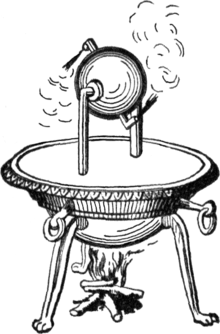Aeolipile

An aeolipile (or aeolipyle, or eolipile), also known as a Heron's engine, is a simple bladeless radial steam turbine which spins when the central water container is heated. Torque is produced by steam jets exiting the turbine, much like a tip jet[1] or rocket engine.[2] In the 1st century AD, Hero of Alexandria described the device, and many sources give him the credit for its invention.[3][4]
The aeolipile Heron described is considered to be the first recorded steam engine or reaction steam turbine.[5] The name – derived from the Greek word Αἴολος and Latin word pila – translates to "the ball of Aeolus", Aeolus being the Greek god of the air and wind.
Pre-dating Heron's writings, a device called an aeolipile was described in the 1st century BC by Vitruvi in his treatise De architectura; however, it is unclear if it is the same device or a predecessor, as he does not mention rotating parts.[6]
Description and physics

The aeolipile consists of a vessel, usually a "simple" solid of revolution, such as a sphere or a cylinder, arranged to rotate on its axis, having oppositely bent or curved nozzles projecting from it (tipjets). When the vessel is pressurised with steam, steam is expelled through the nozzles, which generates thrust due to the rocket principle[7] as a consequence of the 2nd and 3rd of Newton's laws of motion. When the nozzles, pointing in different directions, produce forces along different lines of action perpendicular to the axis of the bearings, the thrusts combine to result in a rotational moment (mechanical couple), or torque, causing the vessel to spin about its axis. Aerodynamic drag and frictional forces in the bearings build up quickly with increasing rotational speed (rpm) and consume the accelerating torque, eventually cancelling it and achieving a steady state speed.
Typically, and as Heron described the device, the water is heated in a simple boiler which forms part of a stand for the rotating vessel. Where this is the case, the boiler is connected to the rotating chamber by a pair of pipes that also serve as the pivots for the chamber. Alternatively the rotating chamber may itself serve as the boiler, and this arrangement greatly simplifies the pivot/bearing arrangements, as they then do not need to pass steam. This can be seen in the illustration of a classroom model to the right.
History
.jpg)
Both Heron and Vitruvius draw on the much earlier work by Ctesibius (285–222 BC), Ctesibius or Ktesibios or Tesibius was a Greek inventor and mathematician in Alexandria, Ptolemaic Egypt. He wrote the first treatises on the science of compressed air and its uses in pumps.
Vitruvius's description
Vitruvius (c. 80 BC – c. 15 AD) mentions aeolipiles by name:
"Æolipylæ are hollow brazen vessels, which have an opening or mouth of small size, by means of which they can be filled with water. Prior to the water being heated over the fire, but little wind is emitted. As soon, however, as the water begins to boil, a violent wind issues forth."[6]
Heron's description
Heron (c. 10–70 AD) takes a more practical approach, in that he gives instructions how to make one:
№ 50. The Steam-Engine.
PLACE a cauldron over a fire: a ball shall revolve on a pivot. A fire is lighted under a cauldron, A B, (fig. 50), containing water, and covered at the mouth by the lid C D; with this the bent tube E F G communicates, the extremity of the tube being fitted into a hollow ball, H K. Opposite to the extremity G place a pivot, L M, resting on the lid C D; and let the ball contain two bent pipes, communicating with it at the opposite extremities of a diameter, and bent in opposite directions, the bends being at right angles and across the lines F G, L M. As the cauldron gets hot it will be found that the steam, entering the ball through E F G, passes out through the bent tubes towards the lid, and causes the ball to revolve, as in the case of the dancing figures.[3]
U.S. Navy use
In recognition of the aeolipile's contribution to steam engineering, the U.S. Navy chose a semblance of the aeolipile for the Boiler Technician rating badge.
Practical usage

It is not known whether the aeolipile was put to practical use in ancient times. Hero's drawing shows a standalone device, and was presumably intended as a "temple wonder", like many of the other devices described in Pneumatica.[3]
Vitruvius, on the other hand, mentions use of the aeolipile for demonstrating the physical properties of the weather. He describes the aeolipile as
…a scientific invention [to] discover a divine truth lurking in the laws of the heavens.[6]
After describing the device's construction (see above) he concludes:
…Thus from this slight and very short experiment we may understand and judge the mighty and wonderful laws of the heavens and the nature of winds.[6]
See also
| Wikimedia Commons has media related to Aeolipile. |
References
- ↑ jet engine
- ↑ NASA Glenn Learning Technologies Project (LTP)
- 1 2 3 Hero (1851) [reprint of 1st century CE original], "Section 50 – The Steam Engine", written at Alexandria, Pneumatica, London: Taylor Walton and Maberly, retrieved 2009-07-03 Translated from the original Greek by Bennet Woodcroft (Professor of Machinery in University College London.
- ↑ Hero (1899). "Pneumatika, Book IΙ, Chapter XI". Herons von Alexandria Druckwerke und Automatentheater (in Greek and German). Wilhelm Schmidt (translator). Leipzig: B.G. Teubner. pp. 228–232.
- ↑ "turbine." Encyclopædia Britannica. 2007. Encyclopædia Britannica Online. 18 July 2007 <http://www.britannica.com/eb/article-45691>.
- 1 2 3 4 "De Architectura": Chapter VI (paragraph 2)
from "Ten Books on Architecture" by Vitruvius (1st century BC), published 17, June, 08 accessed 2009-07-07 - ↑ Aeolipile